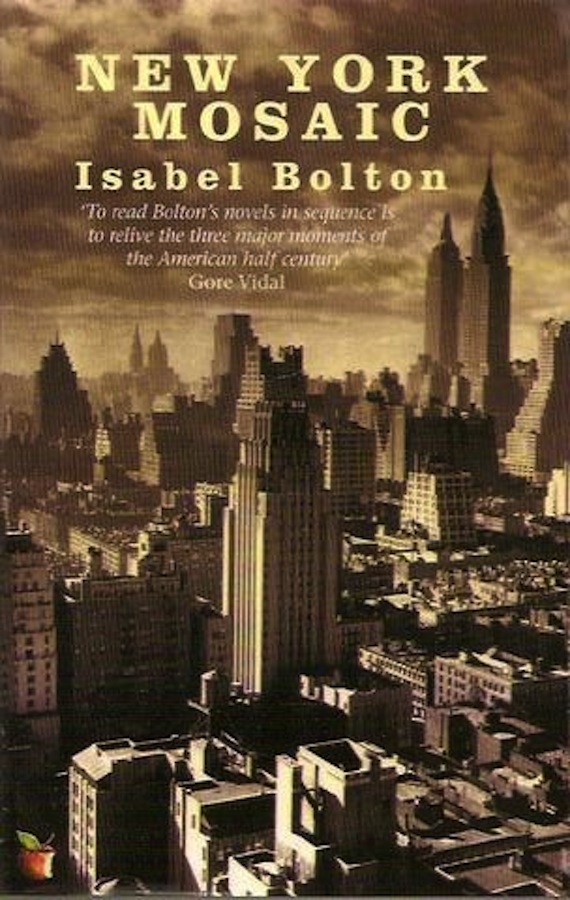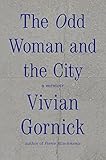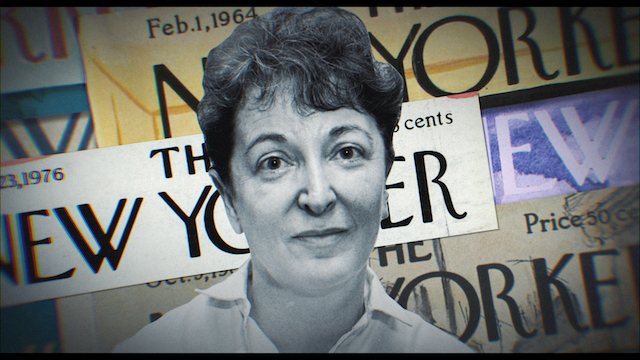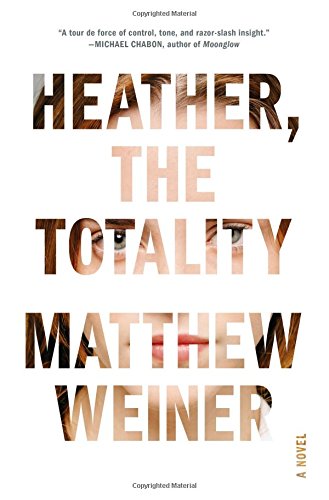
This post was produced in partnership with Bloom, a literary site that features authors whose first books were published when they were 40 or older.
1.
In 1997, the four-year-old independent publisher Steerforth Press published New York Mosaic by Isabel Bolton, in hardback and paperback. A trilogy of Bolton novels that were originally published in the ’40s and ’50s— Do I Wake or Sleep, The Christmas Tree, and Many Mansions —Mosaic is now long out of print. An introduction by Doris Grumbach began with a provocative observation:
It is one of the accepted truths of the publishing world that many good books appear, are critically praised but attract few readers, falling between the cracks of their time, and are never heard of again.
Grumbach had previously suggested to her own editor that he republish The Christmas Tree, but he declined, calling it “old-fashioned.” Now, she wrote, readers of the reissued trilogy would “have the pleasure of encountering, most probably for the first time, a unique (if somewhat ‘old-fashioned’) writer of originality and great power.”
That I came to Bolton’s work via a 1997 rereleased edition of three out-of-print mid-century novels that had itself gone out of print seems to confirm Grumbach’s dire statement. Isabel Bolton has fallen into obscurity a second time. How and why does this happen? What accounts for the failure of a work to catch hold, in spite of outstanding reviews? What makes a critical mass of readers respond favorably, or not? Is there a viable explanation for the truth of Grumbach’s claim?
2.
 In his 1946 New Yorker review of Do I Wake or Sleep, Edmund Wilson, one of the most prominent critics of his day, called Isabel Bolton’s voice “exquisitely perfect in accent.” He compared her stream-of-consciousness prose to Virginia Woolf’s, her technique to Henry James’s — “the single consciousness that observes all”– and the novel’s mood and sensibility to that of Elizabeth Bowen’s Death of the Heart. Diana Trilling at The Nation heaped on more accolades, regretting only that she hadn’t discovered Bolton first. Do I Wake or Sleep was “quite the best novel that has come my way in the four years I have been reviewing new fiction for this magazine,” and Bolton was “the most important new novelist in the English language to appear in years.” Trilling too compares Bolton to Bowen, noting “the same scalpel-like precision of observation and expression.”
In his 1946 New Yorker review of Do I Wake or Sleep, Edmund Wilson, one of the most prominent critics of his day, called Isabel Bolton’s voice “exquisitely perfect in accent.” He compared her stream-of-consciousness prose to Virginia Woolf’s, her technique to Henry James’s — “the single consciousness that observes all”– and the novel’s mood and sensibility to that of Elizabeth Bowen’s Death of the Heart. Diana Trilling at The Nation heaped on more accolades, regretting only that she hadn’t discovered Bolton first. Do I Wake or Sleep was “quite the best novel that has come my way in the four years I have been reviewing new fiction for this magazine,” and Bolton was “the most important new novelist in the English language to appear in years.” Trilling too compares Bolton to Bowen, noting “the same scalpel-like precision of observation and expression.”
Three years later The Christmas Tree was published. Two early excerpts had appeared in The New Yorker, priming fans of Bolton’s first novel for her encore. Trilling wasn’t disappointed. With The Christmas Tree, she wrote, Bolton “establishes herself as the best woman writer of fiction in this country today.” Other reviews were enthusiastic, but with qualifications. The Saturday Review found “her talent, her exquisite sensitivity unmistakable,” her lyric prose “almost perfect” at times, but the second novel not equal to the first.
Bolton’s third novel, Many Mansions, was published in 1952 and was a finalist for that year’s National Book Award; yet reviews were mixed. Kirkus Reviews dismissed its “drawing room elegance and withered gentility.” The American Scholar thought Bolton “conveyed most effectively the peculiar flavor of recollection. One feels very directly the spirited and courageous old woman’s emotional response to life…” — but went on to say that neither the protagonist’s story nor its setting materialized vividly for the reader.
In addition to Woolf, James, and Bowen, Bolton was compared during her brief span of renown to Edith Wharton, Jean Rhys, Katherine Anne Porter, Carson McCullers, Eudora Welty, Truman Capote, and Marcel Proust. Even so, she soon disappeared from the public eye, and the novels went out of print. We don’t have posted sales figures or Amazon ratings from the mid-20th century, but if the reputation of the publisher is any indication, we can’t find fault there: Scribner was of course the venerated publisher of Ernest Hemingway, F. Scott Fitzgerald, Thomas Wolfe, and countless others.
3.
 Finding a fascinating out-of-print author is like stumbling across a hidden garden behind a rundown building or delicious rhubarb pie at a forgotten off-road diner — and just as serendipitous. I first learned of Isabel Bolton from Vivian Gornick’s The Odd Woman and the City. Gornick’s memoir is a series of sketches about her life in New York and New York in her life. In the midst of mostly personal recollections, one vignette begins: “She was born Mary Britton Miller in New London, Connecticut, in 1883…” I read with curiosity about this Mary Miller, who wrote conventional, unremarkable stories and poetry that were published but overlooked. Then at the age of 63, she published Do I Wake or Sleep under the name of Isabel Bolton and became an overnight success.
Finding a fascinating out-of-print author is like stumbling across a hidden garden behind a rundown building or delicious rhubarb pie at a forgotten off-road diner — and just as serendipitous. I first learned of Isabel Bolton from Vivian Gornick’s The Odd Woman and the City. Gornick’s memoir is a series of sketches about her life in New York and New York in her life. In the midst of mostly personal recollections, one vignette begins: “She was born Mary Britton Miller in New London, Connecticut, in 1883…” I read with curiosity about this Mary Miller, who wrote conventional, unremarkable stories and poetry that were published but overlooked. Then at the age of 63, she published Do I Wake or Sleep under the name of Isabel Bolton and became an overnight success.
Gornick was struck by Bolton’s engagement with New York — the three novels’ interplay between the self and the city, loneliness, and solitude. These are Gornick’s own themes. She observes that Bolton “had lived long enough to see that modern life, with its unspeakable freedoms mirrored in the gorgeous disconnect of the crowded city, has revealed us to ourselves as has the culture of no other age.”
Neither Gornick’s discovery, nor mine, would have been possible without Bolton’s brief but fortuitous revival by Steerforth. Gornick herself reviewed New York Mosaic for the Los Angeles Times in 1997. Of the continuity among the three novels and their protagonists, Gornick wrote that each “is presented as a woman able to make her deal with life because she has the city to love, urbanity to merge with.” She referred to well-known women writers of the first half of the 20th century who produced “a kind of poetic, interior, reverie-bound prose clearly influenced by modernism and Freud,” naming Jean Rhys, Anna Kavan, Djuna Barnes, and Virginia Woolf; and expressed her belief that Isabel Bolton “belongs in the ranks of these writers.”
4.
The three novels of New York Mosaic reflect and refract one another, forming a strong, almost continuous narrative. Reading them consecutively in a single tome, I found an enhanced synergy and impact beyond that of three individual books published years apart. Each has a female protagonist — progressively middle-aged to elderly — through whose eyes and musings we see New York at distinct points over a decade. Do I Wake or Sleep (the closing words of John Keats’s “Ode to a Nightingale”) depicts a day in 1939 in the life of 40ish Millicent. The action is removed, and what there is of a storyline — Millicent wants Percy who wants Bridget who goes off with the millionaire — is the path we follow through Millicent’s interior narration, her observations and recollections, her affinity with the city:
There was, she thought, a magic, an enchantment — these myriad rainbow lights, now soft and low, now deeper, stronger — all the stops and chords and colors played like organ voluntaries, over the moon, the clouds, the grass.
Bolton’s narrative voice is absorbing and evocative, her sentences dynamic, fluctuating from crisp — “But here you walked in a vacuum.” — to molten. The following long and florid Jamesian passage, for example, continues for another 200 words:
And seeing suddenly, as though in a magnified and inconceivable vision of the Apocalypse, all the choirs of windows, all the tiers of little lights, the towers and terraces and tenements — the bevies, the hives, the sections and intersections and cross sections of human habitations collapsing, toppling, falling, one upon another, and all together in their downfall proclaiming the final judgment and annihilation…
Like Mrs. Dalloway, the novel takes place in a 24-hour period. Millicent’s inner voice as she extols New York — “What a strange, what a fantastic city — there was something here that one experienced nowhere else on earth” — projects a vivid image of Clarissa Dalloway in London: “Heaven only knows why one loves it so, how one sees it so, making it up, building it round one, tumbling it, creating it every moment afresh…”
I could readily understand the linking of Bolton to Woolf in their reflective voices and rhythmic language, their weaving of past and present.
The protagonist of The Christmas Tree, Hilly Danforth, a widow in her 50s, engages in a precarious juggling act when her gay son, trailed by his recently cast-off lover and her former daughter-in-law with new husband in tow, descend on her for Christmas in post-war 1945. I was struck again by Bolton’s innate sense of narrative flow and structure. With limited action and dialogue, we’re privy to Hilly’s interior voice, her reflections on her own youth as she seeks to understand her son. Bolton broadens the novel’s perspective by contrasting Hilly’s voice with her son’s. On the train from Washington to New York, Larry thinks about the joys of travel:
[I]t eased the body and liberated the mind just to sit and look out of the window, to feel at one with the earth, with sky, part of the physical world, part of the mystery; the train established rhythms; your thoughts moved freely; you wished to go on and on, to have no responsibilities save to this flow, this mysterious sense of time, of space, of memory.
 The straightforward handling of Larry’s homosexuality — this was 1949 — led The Christian Science Monitor to call it “a morality play for moderns.” More recently it was listed in Lost Gay Novels, a 2003 compendium of works from the first half of the 20th century.
The straightforward handling of Larry’s homosexuality — this was 1949 — led The Christian Science Monitor to call it “a morality play for moderns.” More recently it was listed in Lost Gay Novels, a 2003 compendium of works from the first half of the 20th century.
The third novel Many Mansions, opens thus, in 1950:
Miss Sylvester stood at the window. She had finished her manuscript and she sighed heavily. Her novel had left her with a feeling of incredulity occasioned not so much by the fact that her story savored of the unusual, if not to say the melodramatic, as by the positively imponderable strangeness of the human condition, one’s existing in this world at all.
Miss Sylvester’s novel is her own thinly disguised story. Now in her 80s, she reimagines it as she rereads it, and her foray into the past is juxtaposed with present developments. Contrary to the consensus of the original reviews, Babette Deutsch wrote in The American Scholar in 1970 that she found Many Mansions “the most effective of the three” and undeservedly allowed to drop out of sight. She praised Bolton’s style and the story itself, its background of social history and “what the novel has to say and to suggest about the ‘generation gap,’ a phrase that the old lady recognized without naming.” Many Mansions is in fact my favorite of the three novels: by the time I read the last of the trilogy, Bolton’s distinctive voice and mood had securely rooted in my consciousness.
The indictment of gentility notwithstanding, Bolton doesn’t shrink from addressing issues of her day and ours — women’s sexuality, gay oppression, thwarted love, aging, loneliness, failure, change. New York Mosaic left me satisfied like a three-course meal at a fine — classic but not nouveau-chic — Manhattan restaurant. I couldn’t understand Bolton’s absence from the canon of women writers. Surely I would find her in my 1,200-page Bloomsbury Guide to Women’s Literature, but Amely Bolte was followed by María Bombal. Who were they, I wondered; why them and so many obscure others, but not Isabel Bolton?
5.
Bolton published another novel in 1971, The Whirligig of Time. Kirkus Reviews acknowledged that Bolton had made “a small reputation” in the past thanks to her influential supporters, Edmund Wilson and Diana Trilling. But the reviewer doubted that contemporary readers would respond to a “prose style given to budding trees (three times in forty lines) and birds ‘singing, ascending, pausing on the brink of some imperishable bliss,’” and summed up with the opinion that “the perfumed sensibility is just about unbearable.” Twenty years after her ascendancy, Bolton had been dismissed as a flash in the pan or a fluke. The republication of her novels couldn’t resuscitate her in spite of garnering more accolades.
What about the author herself? Little was known about her private life, and it seemed she had chosen to remain an enigma. The only information she provided for her book jackets was that “I have lived some time in Europe…was brought up in America…New York has been my home for many years.” Might her reticence have contributed to her descent?
I was intrigued by Bolton’s mystique and was thus elated when I discovered her memoir, Under Gemini. Bolton tells about Mary Britten Miller and her identical twin, Grace — from age five when they’re orphaned until Grace’s drowning death at 14. For Mary it was “a blotting out of life.” She tells how the two girls, raised by wealthy, distracted relatives and a beleaguered governess, had a joyful existence that revolved around each other. “It was never I but always we,” she wrote. Being an identical twin was, for Bolton, “the source of whatever insight into human nature or response to the beauties and mysteries of the natural world I may possess.” Under Gemini was published in 1966, reissued in 1999. It too fell by the wayside twice; now it’s listed at NeglectedBooks.com.
The trail of Mary Miller aka Isabel Bolton is sparse from then on. She spent a few years in Italy, but there’s no record of them. She lived alone in New York from the age of 28 and never married. There’s speculation that she was a lesbian, rumors of an illegitimate child born in Italy.
We don’t have the life, but we have the work, and the mystery of Isabel Bolton must perhaps be gleaned from her novels. Is Many Mansions partly autobiographical? The novel within the novel, Miss Sylvester’s roman á clef, tells of a young woman who falls in love with a married man and gets pregnant. Her family ships her off to Italy to have the baby, which they have taken from her at birth and given up for adoption.
My favorite Bolton legend is from Gore Vidal’s appreciative 1997 review of New York Mosaic. In the wake of his own first novel being ignored by Edmund Wilson, he recalled Wilson gushing over the 1946 inaugural effort of the unknown Isabel Bolton. Vidal asserted that Wilson was known to have a penchant for nubile flesh combined with writing talent. Thus, with Wilson’s praise of Bolton, Vidal wrote, “a star was born…[and] a comic legend was also born:” as he told it, Wilson projected the loveliness of Bolton’s lyrical prose onto the author herself before learning that his targeted conquest was an imposing 60-something matron. Vidal didn’t know if the two ever met, but he offered a fictional imagining in which Wilson goes to meet Bolton. He’s greeted at her door by a beautiful young woman, his vision personified, and a majestic white-haired woman. Assuming the latter to be Isabel’s mother, she corrects him, explains that she is Isabel Bolton and the girl is her ward. He hears Ms. Bolton calling for smelling salts as he drops to the floor in a faint.
Another scenario appeared in The Man Who Would Marry Susan Sontag: And Other Intimate Literary Portraits of the Bohemian Era by Edward Field, a gossipy account of Yaddo in the ’50s when Bolton was a writer in residence: Wilson had asked to meet her, but she was wary and arranged their encounter at a street-side bench in Central Park. She saw him walk past her, then back and forth several times — no doubt in denial — until she identified herself and squelched his fantasy.
A friend of Doris Grumbach who knew Bolton at Yaddo described her as “imperious, sharp-tongued, demanding, witty, often a delightful conversationalist, and always difficult.” I see those qualities in a 1966 photograph. The overall impression is severe and self-contained, but there’s a glimmer in her eyes and the slightest curve to her mouth — as if someone had asked her about Edmund Wilson.
6.
Grumbach believes Bolton adopted her pen name to remain anonymous, but I question if that’s what she really wanted. It seems more likely that she disassociated herself from earlier failed efforts in order to forge a new identity for her new modernist voice. Either way, her anonymity may have contributed to her fall from grace.
Her reputation was never sufficiently grounded to enable her to compete with contemporary tastes, themes, authors. “Jamesian” is alright for Henry James, but it isn’t what many readers seek in contemporary writers. Doris Grumbach told me she had no idea why Bolton’s work never gained the recognition it deserved beyond these explanations, common to so many authors who fade from view. “Perhaps,” she added, “her rather standard method of narration fell out of favor.” She expressed hope that Bolton’s time will come around again and offered Herman Melville as an example. Melville fell into obscurity not many years after Moby Dick and the notable short stories “Bartleby the Scrivener” and “Benito Cereno.” His centennial in 1911, 20 years after his death, started his revival.
New York Mosaic failed to stimulate a similar resurgence on behalf of Isabel Bolton. But Vivian Gornick raised another flicker out of the ashes, and I’m trying to fan the flames.
Isabel Bolton died in 1975 at the age of 92 in her Greenwich Village apartment. Shortly after her death, a man by the name of Harry Smith delivered a shopping bag to the New York Public Library that contained the papers of Mary Britten Miller from 1947 to 1974. Her correspondence, legal papers, typescripts, galley proofs, and reviews now occupy two boxes in the library’s Manuscripts and Archives Division, an opportunity awaiting the architect of Bolton’s next revival.
















